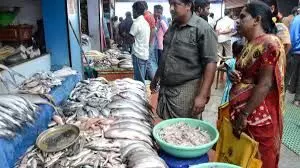Fish consumption in India rises 81% during 2005-2021 period
At the CAGR of 4.05%, the report projected that annual per capita fish consumption is expected to reach 19.8 kg in 2029–2030, 31.7 kg in 2039–2040 and 41.29 kg in 2047–2048
image for illustrative purpose

New Delhi: India's annual per capita fish consumption increased to 8.89 kg in 2021 from 4.9 kg in 2005, indicating changes in dietary mix driven by higher income and rising prosperity, according to a study.
Among fish-eating populations, per capita, annual fish consumption increased from 7.43 kg to 12.33 kg, an increase of 4.9 kg (66 per cent). The study was conducted by WorldFish, the International Food Policy Research Institute (IFPRI) in association with the Indian Council of Agricultural Research (ICAR) and other government bodies.
The timeframe for this study was 2005-2006 to 2019-2021. During the 2005-2021 period, the country's fish production jumped over twofold to 14.164 million tonnes, with a compound annual growth rate (CAGR) of 5.63 per cent.
Out of the total fish output, domestic fish consumption accounted for 82.36 per cent in 2005-2006, 86.2 per cent in 2015-2016 and 83.65 per cent in 2019-2020. The rest was used for non-food purposes and exports.
The study noted that there was a rapid rise in the quantity of imported fish and fishery products for consumption within the country. These increased 543 per cent over the timeframe, with a CAGR of 12.84 per cent, from about 14,000 tonnes in 2005–2006 to 76,000 tonnes in 2019–2020. Considering both locally sourced and imported fish, the total quantity of fish consumed in the domestic market increased 120 per cent to 11.924 million tonnes, from 5.428 million tonnes.
"Annual per capita fish consumption increased from 4.9 to 8.89 kg, an increase of 3.99 kg (81.43 per cent) with a growth rate of 4.05 per cent," said the report titled 'Fish consumption in India: Patterns and trends'.
India outperformed the World Bank's lower-middle income country group, with a 60 per cent increase in per capita fish consumption compared to the group's 45 per cent average, the report said, but added that India's consumption remained lower than the group's average of 14.94 kg in 2020.
"Remarkably, fish consumption is surging faster than the global population growth rate, attributed to rising incomes, heightened awareness of its health benefits and the expanding urban footprint. "Simultaneously, domestic demand for fish in India is on the rise, positioning the nation as the third-largest consumer of fish in the world by volume. However, per capita fish consumption in India continues to lag behind the global average," ICAR Director General Himanshu Pathak said in the report.
This study investigates the dynamics of fish consumption in India from 2005 to 2021, using comprehensive, nationally representative surveys conducted by the Government of India.
According to the report, Tripura had the highest proportion of fish consumers (99.35 per cent) among various Indian states, while Haryana had the lowest (20.55 per cent).
The eastern and northeastern states, Tamil Nadu, Kerala and Goa had the highest fish-eating populations (more than 90 per cent).
Northern states such as Punjab, Haryana and Rajasthan had the lowest ( less than 30 per cent). Kerala (53.5 per cent) and Goa (36.2 per cent) had the highest percentage of daily fish consumers, while Assam (69 per cent) and Tripura (69 per cent) had the highest percentage of weekly consumers.
"Jammu and Kashmir experienced the highest increase (20.9 percentage points) in people eating fish. However, there was a decline in fish consumers in Punjab (3.9 percentage points)," the report said.
India's fish-eating population increased 6.1 percentage points from 66 per cent to 72.1 per cent. "Egg consumers increased 7.35 percentage points, followed by fish (6.1 percentage points), and chicken or meat (5.45 percentage points)," the report said.
"By the end of the surveys, 5.95 per cent of the population ate fish daily, 34.8 per cent weekly and 31.35 per cent occasionally," it added. Fish consumption increased among both genders, with a shift toward weekly consumption.
"Men (78.6 per cent) had a higher fish consumption rate than women (65.6 per cent). Urban areas (42.7 per cent) had a higher proportion of weekly fish consumption compared to rural areas (39.8 per cent). "However, fish consumption increased more rapidly in rural areas than in urban areas, narrowing the gap," the report said. At the current annual growth rate of 4.05 per cent, the report has projected that annual per capita fish consumption is expected to reach 19.8 kg in 2029–2030, 31.7 kg in 2039–2040 and 41.29 kg in 2047–2048.

